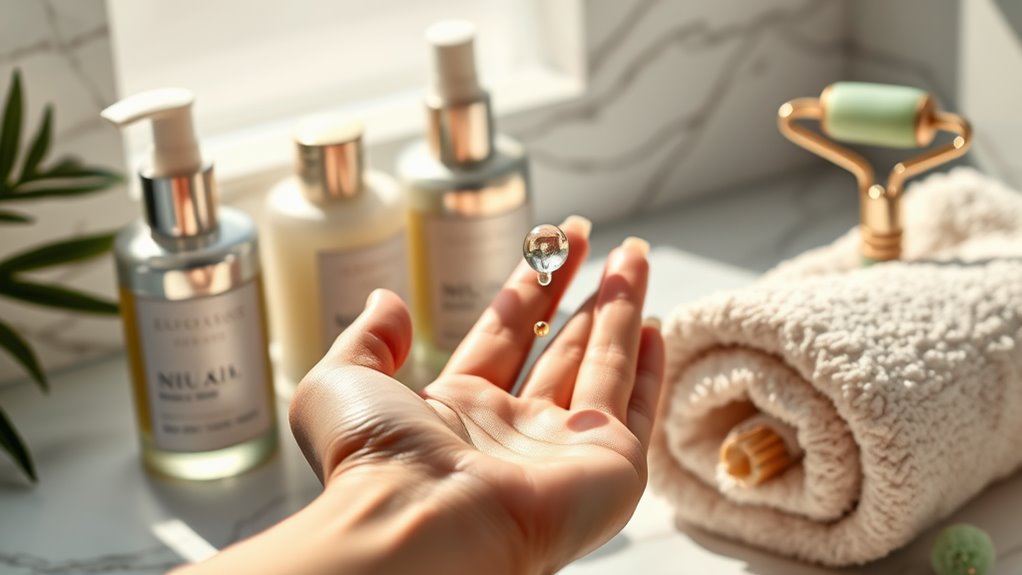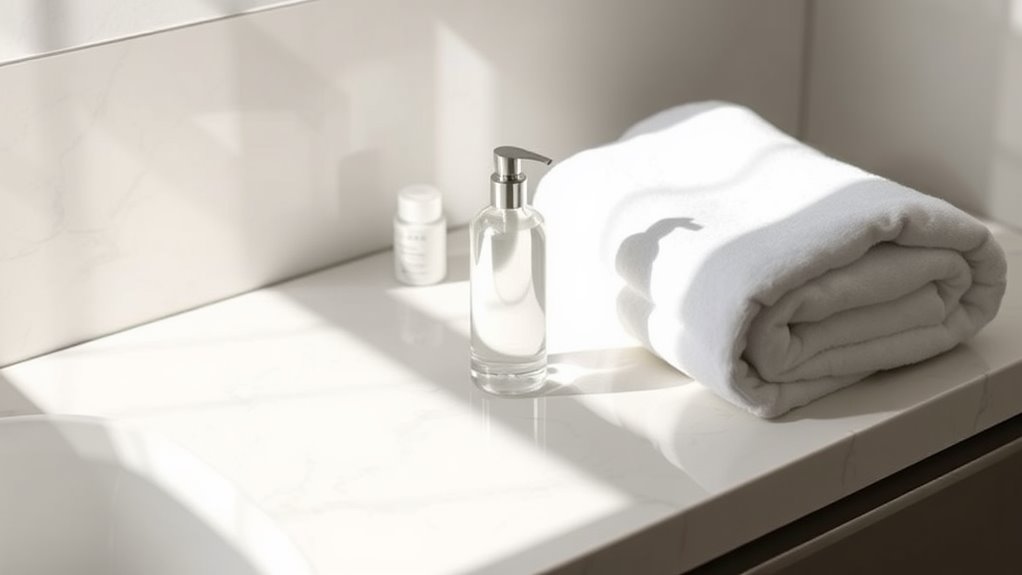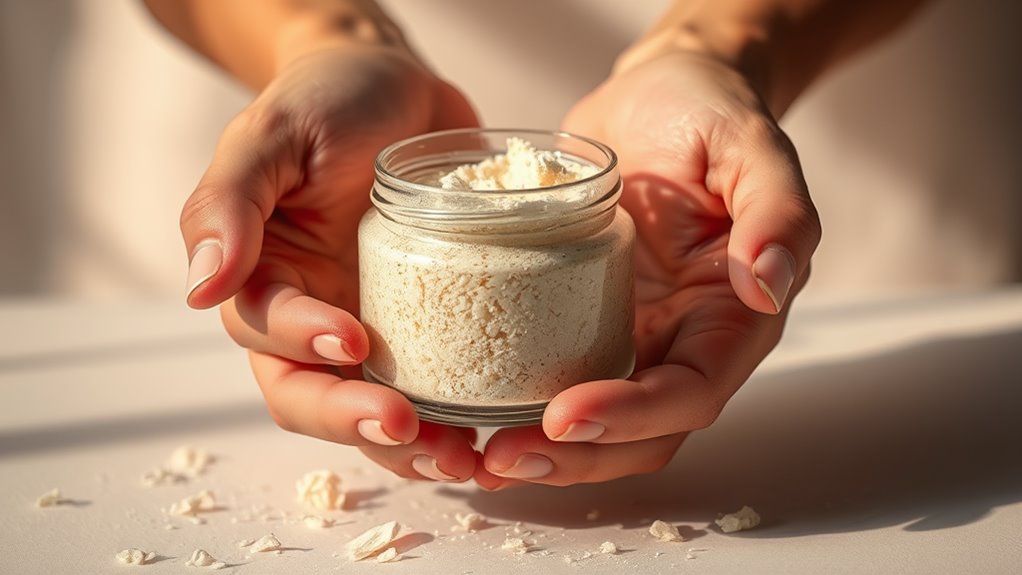What Your Skin Type Says About Your Routine
Your skin type dramatically shapes your skincare routine. Oily skin requires a gentle foaming cleanser and oil-free moisturizer, while dry skin needs a hydrating cleanser and rich moisturizer to prevent tightness. Combination skin demands a careful balance of products, addressing both oily and dry areas, whereas sensitive skin benefits from gentle, fragrance-free products that soothe irritation. Understanding your skin type is essential for selecting the right routine to achieve healthy skin, and more insights are just ahead.
Key Takeaways
- Identifying your skin type helps tailor your skincare routine for optimal results.
- Oily skin benefits from foaming cleansers and lightweight, oil-free moisturizers to reduce shine.
- Dry skin requires hydrating cleansers and rich moisturizers to combat tightness and flakiness.
- Combination skin needs gentle, sulfate-free cleansers and targeted treatments for both dry and oily areas.
- Sensitive skin thrives on gentle, fragrance-free products and calming ingredients to minimize irritation.
Identifying Your Skin Type
How can you accurately identify your skin type? First, cleanse your face with a gentle cleanser and wait for an hour.
Pay attention to how your skin feels. If it’s oily and shiny, particularly in the T-zone, you likely have oily skin. If it’s tight or flaky, your skin may be dry.
Combination skin shows signs of both dryness and oiliness, while normal skin feels balanced and comfortable.
To master your regimen, consider skin type routine tips: for oily skin, incorporate lightweight products; for dry skin, focus on hydration; and for combination skin, tailor your products to each area. Understanding your skin type is crucial to implementing effective skincare practices that yield optimal results, as it allows you to tailor your skincare routine to meet the specific needs of your skin.
Skincare Routine for Oily Skin
When you have oily skin, establishing an effective skincare routine is crucial to managing excess oil and preventing breakouts.
A tailored routine can make all the difference in achieving a balanced complexion.
-
Cleanser: Use a gentle, foaming cleanser with salicylic acid to remove impurities without stripping your skin.
-
Toner: Incorporate an alcohol-free toner containing witch hazel to minimize pores and control shine.
-
Moisturizer: Choose a lightweight, oil-free moisturizer to hydrate without adding extra grease. Additionally, midday shine can often be a result of overactive sebaceous glands, so it’s important to monitor your skin’s response to products.
Skincare Routine for Dry Skin
If you’re struggling with dry skin, establishing a meticulous skincare routine is essential for restoring moisture and maintaining a healthy barrier.
Start with a gentle, hydrating cleanser that won’t strip away natural oils. Follow with a moisturizing toner rich in humectants like glycerin or hyaluronic acid, which attract water to your skin.
Next, apply a nourishing serum containing ingredients like squalane or ceramides to bolster hydration. A rich moisturizer is crucial; opt for one that contains occlusives like shea butter or petrolatum to lock in moisture.
Don’t forget sunscreen—look for a broad-spectrum formula that offers added hydration. Lastly, consider incorporating a weekly hydrating mask to provide an extra moisture boost, ensuring your skin remains supple and healthy. Additionally, avoid common mistakes such as using harsh products that can exacerbate tight, dry skin and compromise your skin’s barrier function.
Skincare Routine for Combination Skin
A balanced skincare routine is vital for managing combination skin, which often features both oily and dry areas.
To effectively address these contrasting needs, consider the following steps:
-
Gentle Cleanser: Use a sulfate-free cleanser that removes dirt without stripping moisture from dry patches.
-
Lightweight Moisturizer: Opt for a gel-based moisturizer to hydrate without clogging pores in oily areas.
-
Targeted Treatments: Incorporate products like salicylic acid for oily zones and hyaluronic acid for drier areas. Additionally, understanding the causes of combination skin can help you choose the best products for your unique needs.
Skincare Routine for Sensitive Skin
Managing sensitive skin requires a tailored approach that prioritizes soothing and calming ingredients. Start with a gentle, fragrance-free cleanser to remove impurities without irritation.
Follow with a hydrating toner featuring calming agents like chamomile or aloe vera, which help restore the skin’s barrier. For treatment, select serums with niacinamide or hyaluronic acid to reduce redness and enhance hydration.
Moisturize using a lightweight, non-comedogenic formula that reinforces the skin’s natural defenses. It’s also essential to be aware of key symptoms of sensitive skin, as they can guide your product choices and routine adjustments.
Finally, don’t skip sunscreen; choose a mineral-based product with zinc oxide to protect without causing irritation. Patch test new products before full application to prevent adverse reactions.




